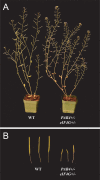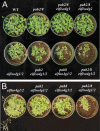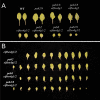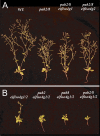Plant growth and fertility requires functional interactions between specific PABP and eIF4G gene family members
- PMID: 29381712
- PMCID: PMC5790229
- DOI: 10.1371/journal.pone.0191474
Plant growth and fertility requires functional interactions between specific PABP and eIF4G gene family members
Abstract
The initiation of protein synthesis requires the involvement of the eukaryotic translation initiation factor (eIF) 4G to promote assembly of the factors needed to recruit a 40S ribosomal subunit to an mRNA. Although many eukaryotes express two eIF4G isoforms that are highly similar, those in plants, referred to as eIF4G and eIFiso4G, are highly divergent in size, sequence, and domain organization. Species of the Brassicaceae and the Cleomaceae also express a divergent eIFiso4G isoform, referred to as eIFiso4G2, not found elsewhere in the plant kingdom. Despite their divergence, eIF4G and eIFiso4G interact with eIF4A, eIF4B, and eIF4E isoforms needed for binding an mRNA. eIF4G and eIFiso4G also interact with the poly(A)-binding protein (PABP) which promotes ribosome recruitment to an mRNA. Increasing the complexity of such an interaction, however, Arabidopsis also expresses three PABP isoforms (PAB2, PAB4, and PAB8) in vegetative and reproductive tissues. In this study, the functional interactions among the eIF4G and the widely-expressed PABP isoforms were examined. Loss of PAB2 or PAB8 in combination with loss of eIF4G or eIFiso4G had little to no effect on growth or fertility whereas pab2 pab8 eif4g or pab2 pab8 eifiso4g1/2 mutants exhibited smaller stature and reduced fertility. Although the pab4 eifiso4g1 mutant grows normally and is fertile, pab4 eif4g or pab4 eifiso4g2 mutants could not be isolated. Even pab4/PAB4 eif4g/eIF4G heterozygous plants exhibited growth defects and low fertility. Mutant co-inheritance analysis in reciprocal crosses with wild-type plants revealed that most ovaries and pollen from pab4/PAB4 eif4g/eIF4G plants were PAB4 eif4g. Similarly, co-inheritance studies with pab4/PAB4 eifiso4g2/eIFiso4G2 plants suggested most ovaries were PAB4 eifiso4g2. These results suggest that a functional interaction between PAB4 and eIF4G and between PAB4 and eIFiso4G2 is required for growth and normal fertility.
Conflict of interest statement
Figures








Similar articles
-
Eukaryotic Initiation Factor eIFiso4G1 and eIFiso4G2 Are Isoforms Exhibiting Distinct Functional Differences in Supporting Translation in Arabidopsis.J Biol Chem. 2016 Jan 15;291(3):1501-13. doi: 10.1074/jbc.M115.692939. Epub 2015 Nov 17. J Biol Chem. 2016. PMID: 26578519 Free PMC article.
-
Competitive and noncompetitive binding of eIF4B, eIF4A, and the poly(A) binding protein to wheat translation initiation factor eIFiso4G.Biochemistry. 2010 Sep 28;49(38):8251-65. doi: 10.1021/bi1008529. Biochemistry. 2010. PMID: 20795652
-
eIF4G, eIFiso4G, and eIF4B bind the poly(A)-binding protein through overlapping sites within the RNA recognition motif domains.J Biol Chem. 2007 Aug 31;282(35):25247-58. doi: 10.1074/jbc.M702193200. Epub 2007 Jul 2. J Biol Chem. 2007. PMID: 17606619
-
[Translational control by the poly(A) binding protein: a check for mRNA integrity].Mol Biol (Mosk). 2006 Jul-Aug;40(4):684-93. Mol Biol (Mosk). 2006. PMID: 16913227 Review. Russian.
-
The role of the poly(A) binding protein in the assembly of the Cap-binding complex during translation initiation in plants.Translation (Austin). 2014 Oct 30;2(2):e959378. doi: 10.4161/2169074X.2014.959378. eCollection 2014 Sep 1. Translation (Austin). 2014. PMID: 26779409 Free PMC article. Review.
Cited by
-
PABPC1 promotes cell proliferation and metastasis in pancreatic adenocarcinoma by regulating COL12A1 expression.Immun Inflamm Dis. 2023 Jul;11(7):e919. doi: 10.1002/iid3.919. Immun Inflamm Dis. 2023. PMID: 37506150 Free PMC article.
-
What, where, and how: Regulation of translation and the translational landscape in plants.Plant Cell. 2024 May 1;36(5):1540-1564. doi: 10.1093/plcell/koad197. Plant Cell. 2024. PMID: 37437121 Free PMC article. Review.
-
The Phytophthora sojae effector PsFYVE1 modulates immunity-related gene expression by targeting host RZ-1A protein.Plant Physiol. 2023 Feb 12;191(2):925-945. doi: 10.1093/plphys/kiac552. Plant Physiol. 2023. PMID: 36461945 Free PMC article.
-
Translational gene regulation in plants: A green new deal.Wiley Interdiscip Rev RNA. 2020 Nov;11(6):e1597. doi: 10.1002/wrna.1597. Epub 2020 May 4. Wiley Interdiscip Rev RNA. 2020. PMID: 32367681 Free PMC article. Review.
-
Genome-wide investigation of the LARP gene family: focus on functional identification and transcriptome profiling of ZmLARP6c1 in maize pollen.BMC Plant Biol. 2024 Apr 29;24(1):348. doi: 10.1186/s12870-024-05054-z. BMC Plant Biol. 2024. PMID: 38684961 Free PMC article.
References
-
- Preiss T, Hentze M. Starting the protein synthesis machine: eukaryotic translation initiation. Bioessay. 2003; 10:1201–1211. - PubMed
-
- Kapp LD, Lorsch JR. The molecular mechanics of eukaryotic translation. Annu Rev Biochem. 2004; 73:657–704. doi: 10.1146/annurev.biochem.73.030403.080419 - DOI - PubMed
-
- Pestova TV, Lorsch JR, Hellen CUT. The mechanism of translation initiation in eukaryotes In: Mathews M.B., Sonenberg N., Hershey J.W.B. ed. Translational Control in Biology and Medicine. Cold Spring Harbor Laboratory Press; 2007:87–128.
-
- Gallie DR. Protein-protein interactions required during translation. Plant Mol Biol. 2002;50:949–970. - PubMed
-
- Wei C-C, Balasta ML, Ren J, Goss DJ. Wheat germ poly(A) binding protein enhances the binding affinity of eukaryotic initiation factor 4F and (iso)4F for cap analogues. Biochem. 1998;37:1910–1916. - PubMed
Publication types
MeSH terms
Substances
LinkOut - more resources
Full Text Sources
Other Literature Sources
Molecular Biology Databases
Miscellaneous

